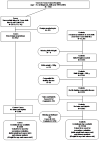Comparison of birth weight corrected for gestational age and birth weight alone in prediction of development of childhood leukemia and central nervous system tumors
- PMID: 19813253
- PMCID: PMC2795053
- DOI: 10.1002/pbc.22308
Comparison of birth weight corrected for gestational age and birth weight alone in prediction of development of childhood leukemia and central nervous system tumors
Abstract
Introduction: High birth weight (HBW) is an established risk factor for childhood acute lymphoblastic leukemia (ALL). The purpose of this study was to evaluate if birth weight (BW) corrected-for-gestational age is a better predictor than BW alone for occurrence of ALL and other malignancies in children.
Materials and methods: Birth certificate data of 2,254 children with cancer who were younger than 5 years old at diagnosis and registered at Texas Cancer Registry during 1995-2003 were compared to 11,734 age-matched controls. Multivariable logistic regression was used to compare models with BW corrected-for-gestational age and BW alone.
Results: Compared to children who were appropriate for gestational age (AGA), children who were large for gestational age (LGA) at birth had a 1.66 times (95% CI 1.32-2.10) higher odds of ALL. Similarly, children with a BW > or =4,000 g had a 1.5 times (95% CI 1.18-1.89) higher odds for ALL, compared to children who weighed >2,500 and <4,000 g at birth. Using model diagnostics, the model containing BW corrected-for-gestational age was a better predictor than the model with BW alone [Akaike's Information Criterion (AIC) 4,646 vs. 4,658, respectively]. Odds ratios (OR) were similar for LGA children who were <4,000 g and LGA children who were > or =4,000 g (OR = 1.5, 95% CI 0.97-2.5 and OR = 1.67, 95% CI 1.29-2.16, respectively). BW was not an independent risk factor for acute myeloid leukemia or brain tumors.
Conclusion: BW corrected-for-gestational age is a better predictor than BW alone of risk for ALL. Future studies using BW variable should incorporate gestational age in their analyses.
(c) 2009 Wiley-Liss, Inc.
Conflict of interest statement
The authors have no conflict of interest to declare.
Figures
References
-
- Okcu MF, Goodman KJ, Carozza SE, et al. Birth weight, ethnicity, and occurrence of cancer in children: a population-based, incident case-control study in the State of Texas, USA. Cancer Causes Control. 2002;13:595–602. - PubMed
-
- Kaye SA, Robison LL, Smithson WA, et al. Maternal reproductive history and birth characteristics in childhood acute lymphoblastic leukemia. Cancer. 1991;68:1351–1355. - PubMed
-
- Robison LL, Codd M, Gunderson P, et al. Birth weight as a risk factor for childhood acute lymphoblastic leukemia. Pediatr Hematol Oncol. 1987;4:63–72. - PubMed
-
- Daling JR, Starzyk P, Olshan AF, Weiss NS. Birth weight and the incidence of childhood cancer. J Natl Cancer Inst. 1984;72:1039–1041. - PubMed
Publication types
MeSH terms
Grants and funding
LinkOut - more resources
Full Text Sources
Medical
Miscellaneous



